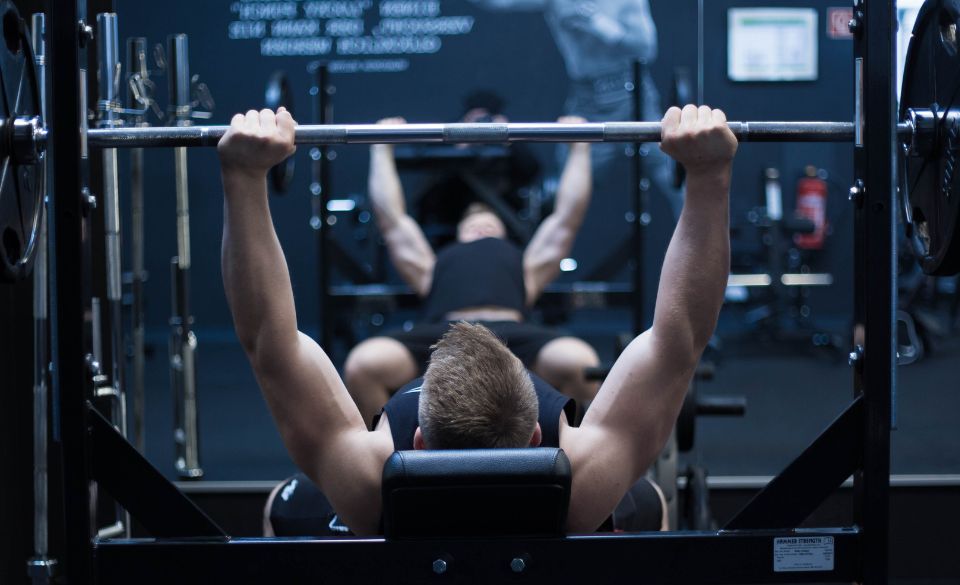
The Military Bench Press: How to, Benefits & Incorporation
Page Contents
Military bench, also known as the standing overhead press, is a popular strength training exercise that has been widely used in military training for many years. This exercise involves lifting a weighted barbell from shoulder height and pressing it overhead until your arms are fully extended. Military bench is an excellent exercise for building upper body strength, improving functional fitness, and increasing muscular endurance. In this article, we will discuss the technique of military bench, its benefits, and how to incorporate it into your fitness routine.
What is a Military Bench
A military bench, also known as a military press bench, is a piece of equipment commonly found in gyms and fitness centers. It is a sturdy bench that is designed specifically for performing military presses, a weightlifting exercise that targets the shoulders and upper body.
The military bench typically consists of a flat, padded bench attached to a sturdy frame. The frame is usually made of metal and has an adjustable barbell rack at one end. The rack allows the user to easily load and unload weights onto a barbell, which can then be lifted overhead during the military press exercise.
The bench is designed to provide a stable and secure platform for the user to perform the exercise. The bench is typically made of a durable material such as steel or aluminum, and the padding is made of high-density foam to provide comfort and support during the exercise.
Military presses are a compound exercise that engage multiple muscle groups in the upper body, including the deltoids, triceps, and upper chest. By using a military bench, users are able to perform this exercise safely and effectively, with the added benefit of being able to adjust the bench to their desired height and angle for optimal performance.
Technique of Military Bench Press
The military bench press is a popular exercise for building strength and muscle in the shoulders, chest, and triceps. However, proper technique is essential to ensure that the exercise is performed safely and effectively.
To perform the military bench press, start by adjusting the height of the barbell rack on the military bench to a comfortable level. Next, load the barbell with the desired amount of weight and secure it onto the rack. Lie down on the bench with your feet firmly planted on the floor, and grip the barbell with your hands slightly wider than shoulder-width apart.
Once you have a firm grip on the barbell, lift it off the rack and bring it down to your chest. Keep your elbows tucked in close to your sides and your wrists straight to prevent any strain or injury.
To perform the lift, exhale and press the barbell up towards the ceiling until your arms are fully extended. Pause briefly at the top of the lift, and then inhale as you lower the barbell back down to your chest in a controlled manner.
It is important to keep your core engaged and your back flat against the bench throughout the exercise. Avoid arching your back or lifting your hips off the bench, as this can put unnecessary strain on your spine.
When performing the military bench press, it is important to start with a light weight and gradually increase the weight as you build strength and improve your technique. It is also important to perform the exercise with a spotter or in a power cage with safety bars in place to prevent injury in case of muscle failure.
By following proper technique and gradually increasing weight, the military bench press can be an effective exercise for building upper body strength and muscle mass.
B. Variations of Military Bench Technique
There are several variations of military bench technique, including seated military bench, dumbbell military bench, and single-arm military bench. Each variation targets different muscle groups and offers its unique benefits.
Common Mistakes during Military Bench
The military bench press is a compound exercise that targets multiple muscle groups in the upper body. However, it is important to perform the exercise with proper technique to prevent injury and achieve optimal results. There are several common mistakes that people make when performing the military bench press, which can compromise their form and limit their progress. Here are some of the most common mistakes to avoid:
Flaring the elbows: One of the most common mistakes people make when performing the military bench press is flaring their elbows out to the sides. This places undue stress on the shoulders and can increase the risk of injury. Instead, keep your elbows tucked in close to your sides and press the barbell up in a straight line.
Lifting the hips: Another common mistake is lifting the hips off the bench during the lift. This puts stress on the lower back and reduces the effectiveness of the exercise. To avoid this mistake, keep your feet firmly planted on the ground and your back flat against the bench throughout the lift.
Not using a spotter: The military bench press is a challenging exercise, and it is important to have a spotter when lifting heavy weights. A spotter can help you lift the weight off the rack and ensure that you maintain proper form throughout the exercise. They can also assist you in returning the barbell to the rack safely.
Improper breathing: Breathing is an essential component of any exercise, and it is important to breathe properly when performing the military bench press. Inhale deeply as you lower the barbell to your chest, and exhale forcefully as you press the barbell back up. This helps to engage your core and stabilize your body during the lift.
Overtraining: Finally, one of the most common mistakes people make when performing the military bench press is overtraining. The muscles in your upper body need time to recover between workouts, so it is important to give them a break and allow them to rest and repair. Overtraining can lead to muscle fatigue, soreness, and injury, so it is important to listen to your body and take a break when necessary.
By avoiding these common mistakes and focusing on proper form and technique, you can get the most out of your military bench press and achieve your fitness goals safely and effectively.
Benefits of Doing A Military Bench Press
Builds Upper Body Strength: The military bench press is a challenging exercise that requires strength and stability in the upper body. By performing this exercise regularly, you can increase your upper body strength, particularly in the chest, shoulders, and triceps. This can help you perform other exercises more effectively and improve your overall athletic performance.
Targets Multiple Muscle Groups: The military bench press is a compound exercise that targets multiple muscle groups at once, including the chest, shoulders, triceps, and even the core. This makes it a time-efficient exercise that can help you get the most out of your workout.
Improves Muscular Endurance: Because the military bench press targets multiple muscle groups, it can also help to improve your muscular endurance. This can help you perform daily activities more easily and reduce your risk of injury.
Enhances Upper Body Definition: The military bench press can also help to enhance upper body definition and create a more aesthetically pleasing physique. By increasing muscle size and reducing body fat, you can create a lean, toned look that is both attractive and functional.
Increases Bone Density: Strength training exercises like the military bench press have been shown to increase bone density and reduce the risk of osteoporosis. By challenging your muscles and bones, you can help to improve your overall bone health and reduce your risk of fractures and other bone-related injuries.
Incorporating Military Bench in Fitness Routine
Incorporating the military bench press into your fitness routine can be a great way to enhance your upper body strength, power, and muscular endurance. Here are some tips to help you incorporate this exercise into your workout:
Warm-Up Properly: Before you start the military bench press, it’s important to warm up properly to avoid injury. Perform some light cardio, such as jogging or jumping jacks, and then perform some dynamic stretching to warm up your chest, shoulders, and triceps.
Start with a Light Weight: If you’re new to the military bench press, start with a light weight to ensure that you have proper form and technique. Gradually increase the weight as you get stronger and more comfortable with the exercise.
Use Proper Form: Proper form is essential when performing the military bench press. Make sure that your back is flat against the bench, your feet are planted firmly on the ground, and your elbows are tucked in close to your body. Keep your core engaged throughout the exercise and avoid arching your back or flaring your elbows.
Incorporate Variations: There are several variations of the military bench press that you can incorporate into your workout, such as incline bench press, decline bench press, and dumbbell bench press. These variations can target different muscle groups and help to keep your workout challenging and effective.
Don’t Overdo It: It’s important to listen to your body and not overdo it when performing the military bench press. Start with a few sets of 8-12 reps and gradually increase the volume as you get stronger. Rest for at least a day in between workouts to allow your muscles to recover and avoid overtraining.
Incorporating the military bench press into your fitness routine can be a great way to enhance your upper body strength, power, and muscular endurance. By following these tips and using proper form and technique, you can perform the military bench press safely and effectively to achieve your desired fitness goals.
Combining Military Bench with other Exercises
Incorporating the military bench press into your workout routine is an effective way to build upper body strength and size, but it’s also important to incorporate other exercises to achieve a well-rounded workout. Here are some exercises you can combine with the military bench press to create a complete upper body workout:
Pull-ups: Pull-ups are an excellent exercise to target the back, biceps, and forearms. Combining pull-ups with the military bench press can help to balance out the muscle groups in your upper body and create a more symmetrical physique.
Shoulder Press: The shoulder press is another effective exercise for targeting the deltoids and triceps. Combining the military bench press with the shoulder press can help to increase overall upper body strength and size.
Dumbbell Flyes: Dumbbell flyes are a great exercise for targeting the chest muscles. Adding dumbbell flyes to your workout routine after performing the military bench press can help to provide a more complete workout for your chest muscles.
Tricep Extensions: Tricep extensions are an excellent exercise for targeting the triceps, which are heavily involved in the military bench press. Combining tricep extensions with the military bench press can help to increase tricep strength and size.
Bicep Curls: Bicep curls are an effective exercise for targeting the biceps, which are also heavily involved in the military bench press. Adding bicep curls to your workout routine can help to increase bicep strength and size, and create a more well-rounded upper body workout.
Incorporating these exercises into your workout routine can help to create a more well-rounded upper body workout and maximize your results. By combining the military bench press with other exercises, you can target all of the major muscle groups in your upper body and achieve a more balanced physique.
Military Bench vs. Regular Bench: A Comparison
When it comes to building upper body strength, the bench press is one of the most popular exercises out there. However, there are different variations of the bench press, including the military bench and the regular bench. Here are some key differences between the two:
Body Position: The main difference between the military bench and the regular bench is the position of your body. During a military bench press, your back is flat against the bench and your feet are together on the ground. This puts more emphasis on the shoulders and triceps. In a regular bench press, your feet are wider apart and your back may be slightly arched, putting more emphasis on the chest muscles.
Range of Motion: The military bench press generally has a shorter range of motion than the regular bench press. This is because the barbell is lowered to the chest and then immediately pressed back up, without the barbell touching the chest. In a regular bench press, the barbell is lowered to the chest and then pressed back up, allowing for a longer range of motion.
Muscles Worked: While both exercises work the chest, shoulders, and triceps, the military bench press places more emphasis on the shoulders and triceps, while the regular bench press places more emphasis on the chest muscles.
Weight Lifted: Typically, you can lift less weight during a military bench press than during a regular bench press. This is because the shorter range of motion and emphasis on the shoulders and triceps make it more difficult to lift heavier weights.
Ultimately, both the military bench press and regular bench press are effective exercises for building upper body strength. The choice between the two depends on your individual goals and preferences. If you want to focus on building shoulder and tricep strength, the military bench press may be a better option for you. If you want to focus on building chest strength, the regular bench press may be more appropriate. Incorporating both exercises into your workout routine can help to target all of the major muscle groups in your upper body and maximize your results.
Conclusion
In conclusion, the military bench press is a great exercise to add to your workout routine if you want to build upper body strength, particularly in the shoulders and triceps. While it may not allow you to lift as much weight as a regular bench press, the unique body position and shorter range of motion can help to target specific muscles and provide variety to your workout. However, it’s important to ensure proper technique and avoid common mistakes in order to prevent injury and get the most out of your workout. Whether you choose to incorporate the military bench press, regular bench press, or a combination of both into your fitness routine, remember to prioritize your goals and listen to your body.



